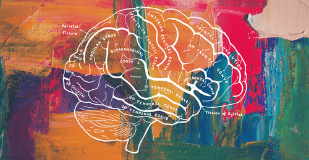It's Time to Get Creative With Your Mental Health

If you’re anything like me, it’s easier to take time for creative activities than it is for things that feel like work—and, more often than I’d like to admit, looking after my mental health can feel an awful lot like work.
For example: I used to be an avid journal-er. I still sometimes dabble in journaling when I need to process intense emotions, but taking the time and energy to write down and reflect on my thoughts can be exhausting, especially in the heat of the moment. When I approach the task of journaling from a creative perspective, however, something shifts. Instead of cataloging every thought or memory, I find myself sifting through the emotions for what feels most present, until I can pull it all together into art.
Comic journaling has proven to be an incredibly cathartic practice for me—it allows me to tell a story to myself, to choose the important pieces and to turn them into something more than words on a page. And while I’m familiar with the idea of art therapy, recently I’ve become increasingly curious about the benefits of creative practices on one’s mental health.
I’m not the only one; studies investigating the connection between art and mental health abound. One such study from 2016 measuring the impact of art-making on cortisol levels showed statistically significant reductions in the hormone after 45 minutes of creative expression. Additional research attributed to Creative Forces®: NEA Military Healing Arts Network—a partnership between the National Endowment for the Arts and the U.S. Departments of Defense and Veterans Affairs—points to the effectiveness of art therapy for military service members, veterans, and families in addressing psychological conditions and more.
The video below shows a TED Talk by art therapist Melissa Walker, who discusses how art helps service members who’ve experienced trauma begin to open up and heal.
If you’re interested in hearing more about the relationship between creative practices and mental wellness, consider checking out Arts For the Health Of It, a podcast for “anyone who wants to discover how and why the arts impact our health, well-being, and society.” Created this year, the show already has 32 episode covering topics from “Music and Dementia” to “Loving Your Body Through Art.”
If, however, you’re more interested in applying the power of creative expression to your own well-being, there are many places to start. For formal support, you could consider finding an art therapist near you. If you’d prefer to start with a less intentionally therapeutic practice, you could enjoy the benefits of a new hobby like knitting or crochet, or try creative journaling the next time you’re feeling upset, unsure, or reflective. An adult (or child’s) coloring book could also be a way to ease into regular creative expression. Whatever feels accessible and compelling to you is a good place to start.
When it comes to discovering what activities and practices best support our own mental wellness, there’s no right answer—only plenty of room for experimentation, exploration, and discovery along the way.
Subscribe for updates
_.webp)



